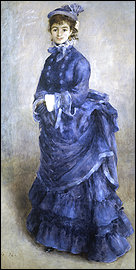 Corcoran ends 'Turner to Cezanne' exhibit early
Corcoran ends 'Turner to Cezanne' exhibit earlyPaul Cézanne's "Francois Zola Dam," 1877-78. (American Federation)
Groundbreaking: The Corcoran exhibit featured the dazzling works of a number of 19th- and 20th-century painters who changed the face of modern art. Shown, Pierre-Auguste Renoir's "La Parisienne," 1874. (Images Courtesy American Federation Of Arts)
The Corcoran Gallery of Art took the extraordinary step Wednesday of closing its major winter exhibition, "Turner to Cézanne: Masterpieces From the Davies Collection, National Museum Wales," after it was determined that new climate control equipment was malfunctioning. The exhibition had not been scheduled to close until April 25.
According to museum officials, the three galleries housing the half-billion-dollar collection did not open Wednesday after the staff decided, in an unusual meeting late Tuesday evening, that air-handling issues for the space needed to be corrected immediately. Another factor, according to the gallery, was a decision by the General Services Administration to suspend its steam system for 72 hours over the weekend.
"There was no damage done to the art. The decision is completely precautionary," said Kristin Guiter, a spokeswoman for the Corcoran. "We had some issues with the new air handler, the one providing the heating and cooling to the gallery. The levels were fluctuating." Those fluctuations, she said, occurred within an acceptable range of variance, but the staff decided not to risk any problems.
Changes in temperature and humidity beyond an acceptable range can have profound effects on works of art. Canvas can expand and contract at a different rate than the paint on the canvas, which can lead to cracking and other damage.
Abruptly closing a well-received show before the end of its scheduled run is almost unheard of. Curators and conservators began de-installing the art Wednesday, Guiter said.
In recent years, the Corcoran has experienced some bumps along the road toward reestablishing itself as an arts destination for residents and out-of-town visitors. It has struggled with fundraising, not unlike many of the region's arts groups during the recession, and the "Turner to Cézanne" show was viewed as a true coup. It was scheduled during a relatively slow time for visitors, ending just after the spring break rush. "It was doing well," Guiter said. "We were definitely disappointed to close it."
The work by the Corcoran's general contractor, the Christman Co., and subcontractor Siemens AG before the exhibition's opening in January was part of an overall roof and skylight restoration, which the company listed as a $16 million project. Attempts to reach representatives of the GSA were unsuccessful, and members of the Corcoran board did not respond to requests for a reaction.
The troubled climate control equipment served only the three galleries, and the remainder of the museum is not affected, Guiter said. The doors to the affected galleries will be closed during the repairs.
The "Turner to Cézanne" show, featuring a dazzling collection of 19th- and 20th-century works, opened in January. The collection belonged to a pair of sisters from Wales, Gwendoline and Margaret Davies, who acquired most of them between 1908 and 1923. The paintings have rarely been seen outside of Europe, and many are by artists who changed the direction of modern art, including Paul Cézanne, Honoré Daumier, Édouard Manet, Claude Monet, Vincent van Gogh and Pierre-Auguste Renoir.
This weekend the Corcoran will open on schedule its next major exhibition, "Helios: Eadweard Muybridge in a Time of Change," Guiter said, and host a family day Sunday.
 Corcoran ends 'Turner to Cezanne' exhibit early
Corcoran ends 'Turner to Cezanne' exhibit early